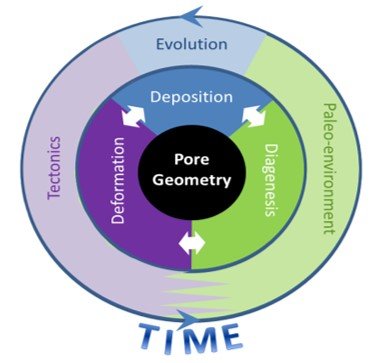
Background
The overarching goal of the PD3 consortium is to build a world-leading centre of expertise in carbonate petroleum geoscience focussed on process-based predictive understanding of deposition, deformation and diagenesis (PD3) in carbonate systems. The consortia is led by University of Manchester in collaboration with the Universities of Bergen, Bristol and Liverpool and is using multiscale field and subsurface data and state-of-the art forward modelling to deliver databases and workflows that can assist with de-risking during carbonate exploration, appraisal and production.
The project aims are achieved by integration of quantitative geological observations and experimental forward models. Process-led interpretations are derived to constrain the controls upon, and interaction of, sedimentological, structural and diagenetic evolution of carbonate platforms and their impact on reservoir properties. The consortium builds on expertise in carbonate geoscience from four leading European Universities:
• University of Manchester offers internationally recognised expertise in carbonate sedimentology, diagenesis and petrophysics with world-class laboratories for digital outcrop modelling, seismic interpretation, petrographical analysis and geochemistry
• University of Bergen has a world-class reputation in tectono-stratigraphy, fault and fracture analysis and digital outcrop modelling
• University of Bristol has an international reputation for hydrogeology, fluid flow modelling and reactive transport modelling
• University of Liverpool provides world-leading research into basin evolution, sequence stratigraphy, seismic and stratigraphic forward modelling
PD3 operates through joint-supervised, integrated, thematic, collaborative postgraduate and post-doctoral research projects.
Rationale
Characterisation of carbonate systems has traditionally focused on outcrop analogue studies to derive conceptual models that explain patterns of carbonate platform growth and diagenetic modification. However, delivery of these often qualitative, static descriptions inhibits the derivation of transferrable rules to explain observed platform architecture, facies mosiacs and diagenetic overprint. Ultimately, this has limited our ability to understand and predict the distribution of porosity and permeability in carbonate systems.
Recent advances in the multi-scale quantification of carbonate geobodies have delivered increasingly robust descriptions of depositional and diagenetic products. However, our understanding of the processes that control the size, shape and distribution of these products remains weak. It is only by unravelling how a particular structural, depositional or diagenetic element was derived that we can constrain both the controls on carbonate sedimentation, and the relative importance of this precursor architecture on porosity modification by subsequent diagenesis and deformation. Once the volume, geometry and connectivity of the resultant pore network is characterised, then a step-change towards inter-well permeability prediction can be made.
Such an approach is ambitious, and requires combined expertise in carbonate sedimentology and diagenesis, basin analysis and structural deformation, geochemistry and petrophysics. By integrating world-class field and laboratory expertise in these disciplines with state-of-the-art process-based forward modelling, this proposal aims to provide such a framework. Ultimately, the program aims to initiate a step-change in our ability to predict carbonate reservoir geometry through the deployment of quantitative databases of carbonate products, forward and 3D geocellular models and rules-sets.
Current projects and research students
-
Lucy Manifold (PhD candidate, University of Manchester): Sedimentological and diagenetic characterisation of Mississippian and Pennsylvanian carbonate platforms
-
David Peacock (University of Bergen): structural controls on sedimentation and diagenesis, Mississippian of Pennine Basin and North Wales Platform, UK
-
Hamish Robertson (PhD candidate, University of Bristol): Multi-scale evaluation of fault-related diagenesis in a rift basin
-
Tan Benjakol (PhD candidate, University of Bristol): Modelling fault-controlled fluid flow during dolomitization
-
Isabella Masiero ((PhD candidate, University of Liverpool): Stratigraphic forward modelling & synthetic seismic images of carbonate strata
Deliverables
-
Digital outcrop data and models from outcrop(s) including geobody dimensions and orientational data accompanying a sedimentological interpretation of the architectural evolution of the study areas, with accompanying petrographical database
-
Stratigraphic and seismic forward models (SFM) to demonstrate impact of changes in relative sea level, subsidence, tectonic uplift, and siliciclastic influx on carbonate platform growth in rift settings
-
Nested fluid flow models to simulate variable density fluid flow, heat and solute transport during burial and uplift in a rift setting
-
Reactive transport models (RTM) to show temporal and spatial evolution of geobodies, and quantification of sensitivity resultant bodies to parameter variation
-
Rules sets, parameterized datasets and decision matrices to assess reservoir presence and risk during carbonate exploration, appraisal and development
-
Bespoke training courses and consultation by all academic staff
-
Additional studies can be undertaken as Masters-level projects at all partner universities
Facilities
-
Access to a world leading community of academics with a track-record of industrially-applied research expertise in carbonate sedimentology, basin analysis & structural geology, mineralogy, diagenesis, geochemistry, hydrology, petrophysics & rock physics, seismic interpretation, 3D X-ray imaging, geocellular and numerical forward modelling.
-
A fully equipped laboratory for digital mapping of outcrops and geocellular reservoir modelling at Universities of Manchester and Bergen including Schlumberger Petrel and Eclipse licences.
-
A well-equipped petrophysical, rock physical and petrological laboratory (plane light petrography, CL, modal analysis, porosity, permeability, Pc, resistivity, Vp/Vs and rock mechanical testing) at University of Manchester.
-
Seismic interpretation laboratory at University of Manchester, including 1Tb seismic data & industry-standard software
-Access to the Manchester X-ray Imaging Facility and the UK’s Synchrotron source, beamline I13L, providing world leading micro- and nano-imaging. Research, collaboration with School of Material Science at University of Manchester
-
Access to the Williamson Resource Centre at University of Manchester(SEM/BSEM, XRD, electron probe micro-analysis, ICP-MS) and software for geochemical modelling (Geochemists Workbench)
-
Fluid inclusion analysis suite at Universities of Manchester and Bergen
-
Forward stratigraphic modelling facilities, including Dionysos and CarboCAT at University of Liverpool
-
Facilities for hydrochemical field characterisation of diagenetic fluids and modelling of diagenetic systems using PHREEQC and TOUGH2, and reactive transport modelling using TOUGHREACT at University of Bristol